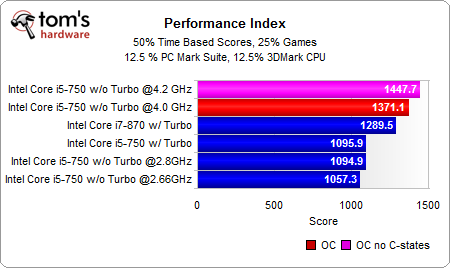Overclocked On Air: Intel's Core i5-750
Conclusion
Our performance expectations were high, but realistic. Intel’s Nehalem architecture is currently king when it comes to performance per clock; we expected it to scale nicely with every megahertz of clock rate added. In fact, the test system based on our MSI P55-GD65 motherboard delivered substantial and mostly linear performance increases up to 4 GHz, where we had to switch off the processor’s internal power management (C-states) to be able to reach the maximum clock speed of 4.3 GHz. Obviously, you don’t really want to do this if you want your idle power kept in check.
Knowing that there are many reports on the Internet showcasing 4.5 GHz speeds and higher, our results seem disappointing. But keep in mind that we ran this overclocking project using Intel’s entry-level Core i5-750 processor, which has a stock clock speed of 2.66 GHz. Looking at a reasonable maximum of 4 GHz, we still realized a clock speed increase of 1.33 GHz, or 50 percent. We also didn’t invest a lot of time on improving cooling. Thermalright’s MUX-120 did a great job, but liquid or more powerful air cooling solutions might give you slightly better overclocking margins.
The Core i5-750 certainly is a great overclocker, but you definitely should set some limits in order to avoid excessive power consumption. Yes, you can get 4.2 GHz performance, similar to many LGA 1366-based platforms with similar overclock settings—but at a much lower price point. Still, we can’t help but posit that conventional, brute-force overclocking might not be such a good idea anymore.
Intel is in the process of altering what overclocking actually means by changing processor specifications from being guided by clock speed to being defined through the thermal envelope. As long as the processor doesn’t reach specific electrical and thermal thresholds, it’s free to run as fast as possible. This is in fact a model that future processor models from both AMD and Intel could be based on. Core i5 and our overclocking project show that static clock rates don’t count anymore. What matters is the clock range and the thermal/electrical envelope the processor operates within. Future overclocking will likely be guided by modifying that range, rather than by reaching a certain maximum clock speed.
We can’t say whether or not the P55 platform is the next BX, but we can state that Core i5/i7 on Intel's LGA 1156 interface makes a lot of affordable sense whether you want to overclock it or not.
Get Tom's Hardware's best news and in-depth reviews, straight to your inbox.
Current page: Conclusion
Prev Page Results: Power Consumption And Efficiency